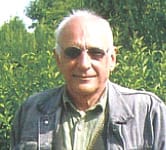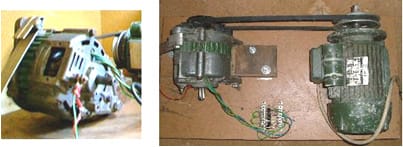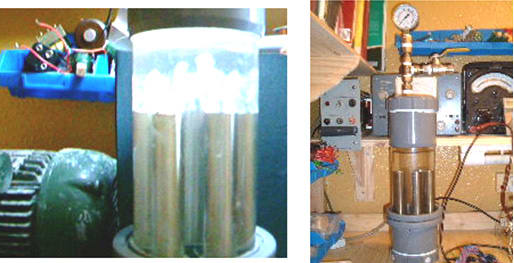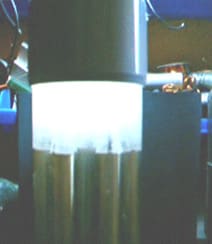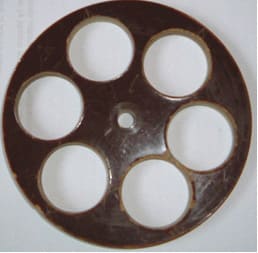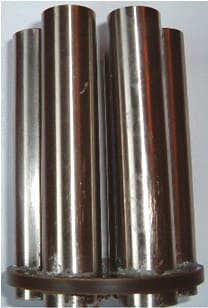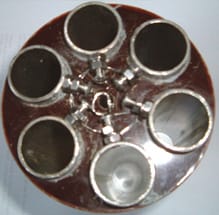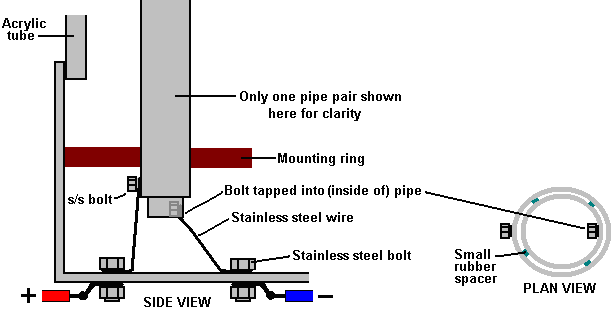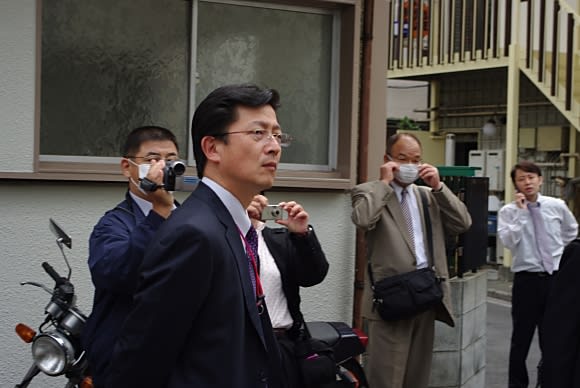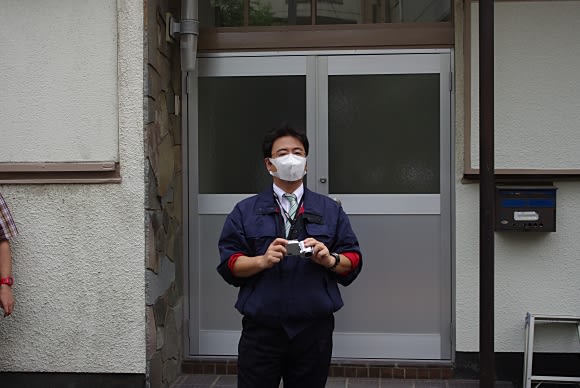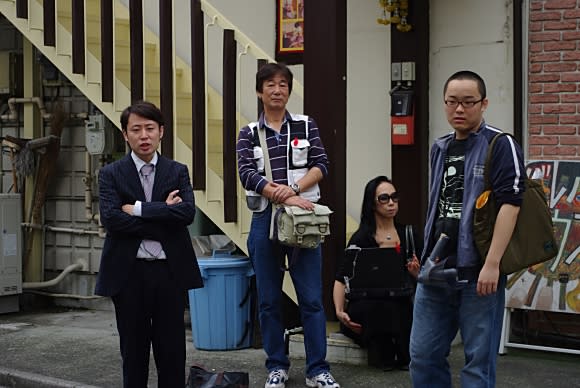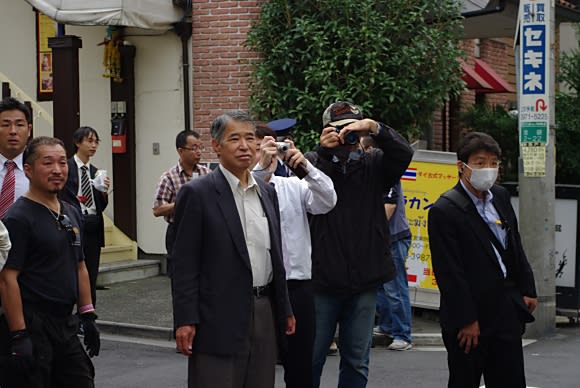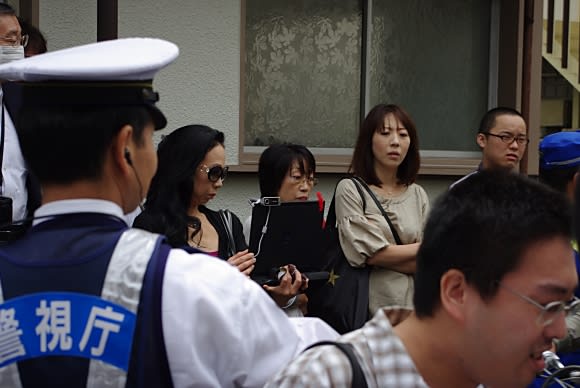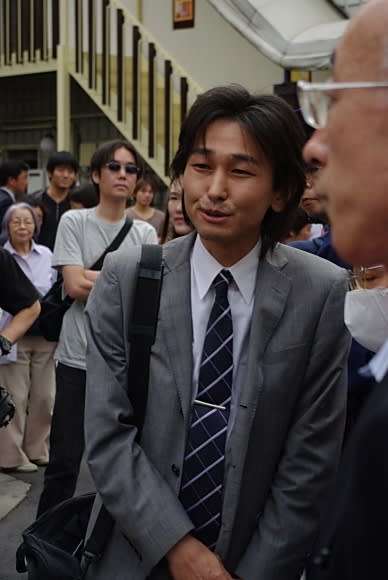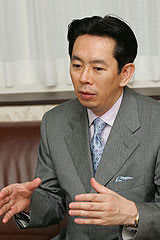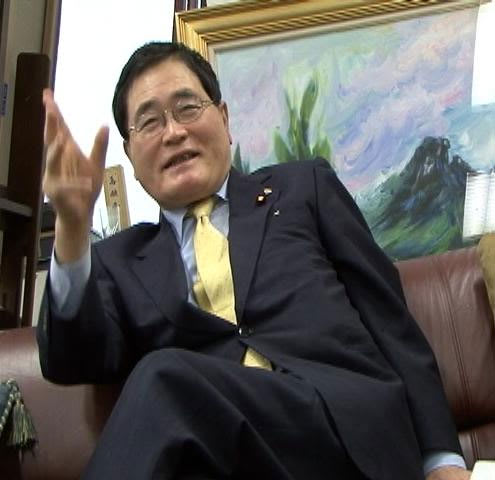Pulsed Water-splitters No.1(パルスを用いた水の分解)
これからの転載は、GhostRiponさん(HN)の力作、傑作、
それではまだ言い足りない........。
勝れた業績である!!
詳しく読めば、誰でも水で走る車、水で起こす電気、水を利用して、
エネルギー革命が出来る!!
貧者のエネルギー革命が、今すぐそこにある。
トンデモ話では決してない。そう思う前に、目を皿にして、少なくとも高校程度の科学力を思いだして、読んで頂ければすぐ解ることである。それでもトンデモ話という人は、2つ考えられる。
一つは、理解力に乏しい人。
二つは、都合が悪いから、邪魔したい人
それしかない。それ以外の人は、自ら追求してみる必要が残っている。それでも疑問がある場合は、議論にも参加しよう。それもしない人は多分目も通すことはないであろう。それは自由である。何も興味のないことに無駄な時間を割く必要はさらさらにない。好きな道を歩むべきだ。
かつて、地球が回ると言ったガリレオ・ガリレイを宗教審判にかけた。そんな愚を犯す時代ではない。誰でもちょっと探ろうと思えば、真実に行き当たる時代である。
まずは、読んでみよう。驚く地平が待っている。
冗長になるが、一つだけ書いておきたい。
投稿者が、燃える水について興味を持ったのは、昭和59年(1984年)であった。日本青年会議所のメンバー集会で、時の寵児、故坪内寿夫氏 の講演に接したときである。あの時のことをまざまざと思い出す。
氏は、『秋田の青年から相談を受けた。水を燃やして燃料に出来る技術を開発した。後援をお願いしたいと言う趣旨であった。そして、その相談者と会い、見聞した。本物であった。しかし、断った。それは時期早尚と言うことである。どんな勝れた発明発見でも、時期というものを外して、成功するものではない。私は、止めなさいと、言った。』と発言をした。
鮮明に覚えている。その時、どういう原理か知るよしもないが、あの故坪内寿夫氏が言明するからには、確かな話に違いない、と、ずっと頭に残っていた。その後の談もあるが、それはさておき、その原理が、今明らかになる。
Pulsed Water-splitters No.1(パルスを用いた水の分解)
テーマ:エコ&エネルギー
まえがき:
Stanley Meyer (スタンレー・マイヤー)氏の、『水で走る自動車』 について、
技術を詳しく解説している日本語サイトが無いので、翻訳しようと思いました。
たんに私が興味をもって、知りたかっただけなのですが、まとめも兼ねて載せます。
簡単に説明すると、『水を燃やす技術』です。
私は、ブラウン・ガスが実用化されていることを知っていたので、これも可能だろうと思えますが、
疑問点も多いので、より突っ込んで知りたかったのが本音です。
信じる信じないの主観的な解釈は重要ではなく、実際に可能かをクールに調べたいと思います。
具体的な目的は2つ。
1つ目は、トンデモ科学かどうかの検証。(理論の検証)
2つ目は、正確な複製品を製作するため。(動作の検証も兼ねたい)
それと、この技術とブラウンガスの技術が、同じなのかも知りたいですね。
理解できればOKと思いますので、訳はフィーリング意訳です。
(読んでみて怪しいところは原文で確認してください)
『百聞は一見にしかず』、興味ある人は、読んで製作して下さい。
難しくないと思いますよ。
A Practical Guide to Free-Energy Devices
Author: Patrick J. Kelly
Chapter 10: Automotive Systems No.1
http://www.free-energy-info.co.uk/Chapt10.html
3. Pulsed Water-splitters
There
is a much more efficient way of converting water into a hydroxy gas
mix. Unlike the electrolysis devices already described, this method
does not need an electrolyte. Pioneered by Stanley Meyer, pulse trains
are used to stress water molecules until they break apart, forming the
required gas mix. Henry Puharich also developed a very successful
system with a somewhat different design. Neither of these gentlemen
shared sufficient practical information for us to replicate their
designs as a routine process, so we are in a position today where we
are searching for the exact details of the methods which they used.
水
素ガスミックス(水素と酸素の混合ガス)を水から分解し取り出すのに、従来よりはるかに効率的な方法があります。
既に説明された電解装置と異なって、この方法は電解質を必要としません。
直流パルスにより水分子にストレスを与えて分解する方法は、スタンリー・マイヤー氏によって開発され、水分子が分解されると水素ガスミックスになります。
また、ヘンリーPuharich氏は、少々異なった設計で非常にうまくいくシステムを開発しました。
前出の両者共、私たちが通常の過程としてシステムを複製できる実用的な情報を共有しなかったので、私たちは彼らが使用した方法の(正確な)詳細を調査しよ
うと思います。
The first significant replication of which I am
aware, came from Dave Lawton of Wales. By using very considerable
tenacity, he discovered the practical details of how to replicate one
of Stan Meyer's early designs which is called by the rather confusing
name of the "Water Fuel Cell". Dave's work was copied and experimented
with by Ravi Raju of India who had considerable success and who posted
videos of his results on the web. More recently, Dr Scott Cramton of
the USA has adapted the design construction slightly and achieved very
satisfactory rates of electrical efficiency, producing some 6 lpm of
hydroxy gas for just 3 amps of current at 12 volts.
私
が気づいた最初の重要な情報は、ウェールズのデイブ・ロートン氏から来ました。
彼は、非常に粘り強く、スタン・マイヤー氏が初期に設計した通称「水燃料Cell」と呼ばれるものの、実用的な詳細を見つけ出しました。
デイブ氏の複製品は、動作の結果をウェブ動画で貼り出したことによって、その結果を見たインドのラビ・ラジュ氏により複製され、実験も成功を納めました。
さらに最近は、米国のスコットCramton博士が設計をさらに改良して、12ボルト3アンペアの電気で、約6L/minの水素ガスを生産して分解効率の
非常に申し分ないレートを達成しました。
The video of Dave Lawton’s replication of Stanley Meyer’s demonstration electrolyser (not Stan's production system) seen here
has caused several people to ask for more details. The electrolysis
shown in that video was driven by an alternator, solely because Dave
wanted to try each thing that Stan Meyer had done. Dave’s alternator
and the motor used to drive it are shown here:
こ
こで見られたスタンレーマイヤー氏のデモンストレーション電解槽「水燃料Cell」(スタンのプロダクションシステム)のデイブ・ロートン氏が複製し動作
させたビデオは、何人かの人に詳細についての質問を受けました。
そのビデオにおいて示された電気分解は、交流発電機により動かされていたからです。なぜなら、デイブ氏は、スタンマイヤー氏が設計した様々な方法を試した
かったからです。 それを動かすために使用されたデイブ氏の交流発電機とモーターは、ここに示されます:
The
technique of DC pulsing requires the use of electronics, so the
following descriptions contain a considerable amount of circuitry. If
you are not already familiar with such circuits, then you would be well
advised to read through Chapter 12 which explains this type of circuitry from scratch.
直
流パルス化の技術は、エレクトロニクス技術(電子工学)の使用を前提とします。従って、以下の説明には、電気回路がかなりの量を占めます。
もしすでにそのような回路に精通していないならば、このタイプの電気回路を最初から説明する12章を、通読するようにアドバイスします。
The
field coil of Dave's alternator is switched on and off by a
Field-Effect Transistor (a “FET”) which is pulsed by a dual 555 timer
circuit. This produces a composite waveform which produces an
impressive rate of electrolysis. The tubes in this replication are made
of 316L grade stainless steel, five inches long although Stan’s tubes
were about sixteen inches long. The outer tubes are 1 inch in diameter
and the inner tubes 3/4 inch in diameter. As the wall thickness is 1/16
inch, the gap between them is between 1 mm and 2 mm. The inner pipes
are held in place at each end by four rubber strips about one quarter
of an inch long.
デイブ氏の交流発電機の磁場コイルは、2つの555チップ
(タイマー回路)によりパルス化され、電界効果トランジスタ(「FET」)によりオンオフを切り替えられます。
これは、電気分解に有効な周波数レートとパルスからなる合成波形を生み出します。
このCellの管(チューブ電極)は、316Lグレードのステンレス鋼で作られて、スタン氏の管は長さ約16インチ(406mm)のであったけれども、こ
れは長さ5インチ(127mm)です。
外側(+)の管は直径1インチ(25.4mm)、内側(-)の管は直径3/4インチ(19mm)のチューブです。
肉厚が1/16インチ(1.6mm)であるので、それらの間のギャップは1mmから2mmまでの間になります。
内側のパイプは、両端に各4つゴム製の細片(約1/4 of 長さ1インチ)により保持されます。
The
container is made from two standard 4 inch diameter plastic drain
down-pipe coupler fittings connected to each end of a piece of acrylic
tube with PVC solvent cement. The acrylic tube was supplied already cut
to size by Wake Plastics, 59 Twickenham Road, Isleworth, Middlesex TW7
6AR Telephone 0208-560-0928. The seamless stainless steel tubing was
supplied by www.metalsontheweb.co.uk
容
器は、PVC溶解力がある接着剤で、アクリルパイプの両端を、4インチ直径の排水管用プラスチック製フタで固定した器具から作られます。
アクリルパイプの切断販売元、59 Twickenham Road, Isleworth, Middlesex TW7 6AR
Telephone
0208-560-0928。シームレス(つなぎ目無し)のステンレス鋼管はwww.metalsontheweb.co.ukにより供給されました。
It
is not necessary to use an alternator - Dave just did this as he was
copying each thing that Stan Meyer did. The circuit without the
alternator produces gas at about the same rate and obviously draws less
current as there is no drive motor to be powered. A video of the
non-alternator operation can be downloaded here.
交
流発電機を使う必要はありません。- デイブ氏は、スタンマイヤー氏が設計制作した個々の設計を複製する際にこれも作りました。
交流発電機なしの回路はおよそ(発電機ありと)同じレートでガスを生産しますが、電流を供給されないとシステムが動かないので、少ない電流を必要としま
す。 交流発電機なしのビデオは、ここでダウンロードできます。
Dave's electrolyser has an acrylic tube section to allow the electrolysis to be watched, as shown here:
デイブ氏の電解槽(電解Cell)は、電気分解の過程が見えるように、透明アクリルパイプ部分を持っています:
The
electrolysis takes place between each of the inner and outer tubes. The
picture above shows the bubbles just starting to leave the tubes after
the power is switched on. The picture below shows the situation a few
seconds later when the whole of the area above the tubes is so full of
bubbles that it becomes completely opaque:
電気分解は、外管と内管の間から起こります。 上の写真は、電源スイッチを入れたあと泡が出始めたときのものです。 下の写真は 数秒後の状況で、管の上部エリア全体に泡がたまり不透明になりした。 :
The
mounting rings for the tubes can be made from any suitable plastic,
such as that used for ordinary food-chopping boards, and are shaped
like this:
チューブを支える設置リングは、どのような素材のプラスチックから作ってもよい、普通のまな板を加工して作ってもかまいません:
And the 316L grade stainless steel, seamless tubes are held like this:
そして、ステンレス316Lのシームレス(つなぎめが無い)管が保持されます:
Here is the assembly ready to receive the inner tubes (wedged into place by small pieces of rubber):
ここには、インナーチューブを受け入れる用意ができているアセンブリがあります(インナーチューブを入れた後、ゴムの小さいスペーサーを支えで押し込みます):
The
electrical connections to the pipes are via stainless steel wire
running between stainless steel bolts tapped into the pipes and
stainless steel bolts running through the base of the unit:
パイプとの接点の接続は、ステンレスワイヤーを使用して行います。パイプとユニットベースと固定はステンレス製ボルトで行います:
The
bolts tapped into the inner tubes should be on the inside. The bolts
going through the base of the unit should be tapped in to give a tight
fit and they should be sealed with Sikaflex 291 or marine GOOP bedding
agent which should be allowed to cure completely before the unit is
filled for use. An improvement in performance is produced if the
non-active surfaces of the pipes are insulated with any suitable
material. That is, the outsides of the outer tubes and the insides of
the inner tubes, and if possible, the cut ends of the pipes.
インナーチューブに固定されるボルトは、頭が内側にあるべきです。インナーチューブは、上端をアウターと位置、下端はボルトでの固定分長くなるようにカット。 上の図参照。
While
Dave’s style of construction is simple and straightforward, recently, a
copy of one of Stan Meyer’s actual construction drawings has surfaced.
The image quality of this copy is so low that much of the text can’t be
read, so the replication presented here may not be exact or might be
missing some useful item of information. Stan’s construction is
unusual. First, a piece of plastic is shaped as shown here:
デ
イブ氏の作った構造は単純で、複雑ではない。最近になって、スタン・マイヤー氏が実際に描いたと思われる、図面のコピーが1つ見つかりました。
このコピーは、画質がとても悪いので、テキストの多くは読むことができず、従って、ここで提示された複製が正確であるかどうかもわからず、また、重要な情
報や部品を見逃しているかもしれません。 スタン氏の構造は独特です。 まず最初に、プラスチックの部品は、ここに示されるように形づくられます:
The
size of this disc is matched exactly to the piece of clear acrylic used
for the body of the housing. The drawing does not make it clear how
this disc is attached to the acrylic tube, whether it is a tight push
fit, glued in place or held in position with bolts which are not shown.
The implication is that a ring of six bolts are driven through the top
and tapped into the acrylic tube, as these are shown on one of the plan
views, though not on the cross-section. It would also be reasonable to
assume that a similar ring of six bolts is also used to hold the base
securely in position. There is a groove cut in the plastic base to take
an O-ring seal which will be compressed tightly when the disc is in
place. There are either two or three threaded stud recesses plus two
through holes to carry the electric current connections. The pipe
support arrangement is unusual:
この(上の図)ディスクのサイズ
は、溝のある径の小さい部分が、透明なアクリルパイプ(容器)に正確に入るようになってます。
それが、きついはめ合いであるかどうか、適所で接着されるのか、または示されないボルトで定位置に保持されるのか、どのようにこのディスクがアクリルパイ
プに取り付けられるか、図面には記載されておらずわかりません。
推測される中心の穴は、6つの穴の開いたプラスチックリング(電極チューブが6本はまっている)をボルト固定するための穴ではないか。その為には、6つの
穴の開いたプラスチックリングはそこそこの固さでアクリルパイプに固定されていると考えるのが妥当かもしれない。ディスクには、アクリルパイプにはめたと
きに、水が漏れないようにするための、Oリング用の溝が切ってあります。 残りのスタッド穴は、電流を接続する為の電極に使われるのではなかろうか。
パイプサポート配置は独特です:
感想:
スタンレーマイヤー氏が初期に設計した、デモンストレーション電解槽「水燃料Cell」の、
1インチ径6本電極バージョンの解説だと思います。
内容にある通り、資料をかき集めて、相当詳しく解説していると思います。
複製品の製作にあたっては、最終仕様の資料だけでも可能ですが、それだけだと理論や部品の
変遷が追えないので、面倒ですが古いバージョンから全部を訳してます。
遠回りなようで、これが近道だろうと思います。
注意)Stanley Meyer、Stan Meyer、スタンレー・マイヤー、スタン・マイヤー、スタンレー・メイヤー、
スタン・メイヤーは、同一人物です。
No.2では、バージョンアップされた3/4インチ径9本電極バージョンです。
Pulsed Water-splitters No.2(パルスを用いた水の分解)
http://ameblo.jp/ghostripon/entry-10331992718.html
■関連記事
Stanley Meyer Data特許資料(英文) [pdf 221ページ]
http://www.free-energy-info.co.uk/MeyerData.pdf
Stanley Meyer - It Runs On Water(水で走る自動車)
http://ameblo.jp/ghostripon/entry-10328859717.html
【資料】Stanley Meyer - It Runs On Water(水で走る自動車)
http://ameblo.jp/ghostripon/entry-10330431267.html
原子水素ガス - HHO GAS - ブラウン・ガス -
http://ameblo.jp/ghostripon/entry-10323958738.html
【続】原子水素ガス - HHO GAS - ブラウン・ガス -
http://ameblo.jp/ghostripon/entry-10328872198.html
燃える塩水 - Salt Water -
http://ameblo.jp/ghostripon/entry-10323134471.html
Byron New Energy - チャージ水 - charged water -
http://ameblo.jp/ghostripon/entry-10324533613.html
【転載終了】










